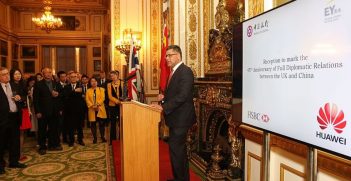Pakistan's Game-Changing Opportunity

As China flexes its economic clout, its new Silk Road is linking the country with the entire Eurasian continent. One consequence is a game-changing opportunity for a struggling Pakistan; but not without risk.
In 2010, political and business leaders in Lahore expressed to me their concerns about the future of Pakistan’s flagging economy, and their inability to identify sources of large-scale foreign investment to rectify this. India was seen as the most proximate source, but impractical for political and strategic reasons. China was not then seen as the logical alternative.
In 2013, China unexpectedly loomed as the ‘game-changer’, with the announcement of its new ‘Silk Road’— what became the One Belt One Road (OBOR) initiative—which included the potential for a China Pakistan Economic Corridor (CPEC). The CPEC concept became a reality in May 2015 when China’s Premier Xi Jinping, then visiting Islamabad, and Pakistan’s Prime Minister Nawaz Sharif, signed some 51 agreements and memorandums of understanding for new investments over the next 15 years. China pledged an initial USD$46 billion (AUD$57 billion) for these investments, including some USD$34 billion for power, and the remainder for road, rail and port infrastructure.
China is the principal beneficiary of CPEC, but Pakistan, as the principal landlord of the corridor, is very much a mutual beneficiary. Both will share the benefits and risks.
At the heart of CPEC is a two-way 3,200km road, rail, and oil and gas pipeline corridor from Kashgar in China’s western Xinjiang province to Pakistan’s deepwater Gwadar port on the Indian Ocean in southwest Baluchistan province. Gwadar port will provide China with a new maritime access route to import and export markets in the Middle East, Europe and Africa.
For related goods, shipping times to China’s east coast ports will be significantly shorter, and bypass the strategically vulnerable Malacca Straits (through which some 80 per cent of China’s imports presently transit). The land corridor will also provide China with two-way access, via Torkham (near Peshawar) in Pakistan’s northwest, to Afghanistan and the Central Asian republics (CARs). Core elements of this corridor, inclusive of related essential support industries, are currently expected to be fully operational by 2020.
Transport investment will significantly upgrade four major transport routes: the northern route, or Karakoram highway (KKH) between Kashgar to Islamabad; the western road/rail route from Islamabad to Gwadar, including connectivity to Torkham; the eastern route from Gwadar via Karachi to Lahore; and the central route comprising interconnecting roads between the east and west routes. Oil and gas pipelines are also under construction from Gwadar to transport gas from Iran to China. The Iranian end of the gas pipeline is already complete, awaiting connectivity to the Pakistan/China link.
The Gwadar port development, for which China has pledged USD$500 million, ultimately will include a new international airport, hospital, technical school, a major power station and desalination plant, and a proximate special industrial zone and tourist area. The core of the new port facility is largely completed. The estimated population and annual maritime freight in 2016 of some 80,000 people and half a million tonnes respectively is expected to grow to more than 400 million tonnes and two million residents when the entire complex is completed.
The bulk of China’s pledged financial investment targets a progressive increase in electricity supply, through the construction of new hydro, wind, solar, gas and coal-fired power stations. If all proposed power stations were built they would add some 17,000 MW to, or nearly double, Pakistan’s electricity capacity. Of this, some 10,400 MW is scheduled to come on stream by 2020. However, at least one proposed hydro power station (4,500MW capacity) in Pakistan-occupied Kashmir is on indefinite hold due to sovereignty claims by India to that area.
CPEC will impact on Pakistan economically, politically and strategically. Economically, in addition to becoming a major trade and transit hub for China, the cumulative direct and indirect benefits in 2030 would, by one estimate, amount to 17 per cent of GDP compared to 2015, and create up to 700,000 new jobs. Additional non-international institutional financing is expected to come from new direct investment by Pakistani entrepreneurs, public-private partnerships, and joint ventures between Pakistan and foreign investors. Many of the latter are expected to include Chinese corporations seeking to expand their own offshore manufacturing and marketing opportunities This change of economic profile will have its own political implications, domestically and internationally.
The strategic implications will also be significant, not only for China (especially if Gwadar becomes a de facto port for the Chinese navy), but also for Pakistan, as its status grows; for India and Iran, as Pakistan’s immediate neighbours; and for the US, especially as Pakistan moves increasingly into China’s sphere of influence.
Pakistan’s entwinement with China across all elements of CPEC will be challenging and require a very high level of mutual trust, consultation and cooperation. China will need to work hard at ensuring Pakistan continues to see CPEC as an equally beneficial partnership.
Where quality of construction and budgeting is critical, the Chinese have imported their own supervisors and skilled labour (currently about 7,000 personnel). Gwadar, for example, is being built, and will be operated under a 40-year lease, by China. Various similar combinations apply, or will apply, to other infrastructure and support industries, including power stations. Some Pakistanis have already noted some concerns about this, and questioned China’s intent to develop and transfer management and labour skills.
Political stability and physical security in Pakistan, especially along key corridors, are also major concerns for both. One major security measure has been the creation of a special Pakistan army division to protect Chinese labour from physical threats and infrastructure from sabotage, especially in the western provinces of Baluchistan and Khyber Pakhtunkhwa. The diversity offered by central route connections between the east and west routes will increase transport security through this area.
The one significant grey area of CPEC is its financing. Little is known about the details of Chinese funding. Most appear to be loans, not outright grants, often in Chinese yuan, with firm repayment conditions, mostly guaranteed by the Pakistan government. Debt repayment will require the profitability of direct and indirect investments, or other offset arrangements. However, there is some doubt whether Pakistan could fully meet related debts, especially if all proposed CPEC investments proceed, and what likely default arrangements would apply should that occur. Already, some less critical projects have been dropped or suspended due to concerns about financial viability.
Notwithstanding a lack of transparency of funding, the implementation of core CPEC projects over the next two years should meet Pakistan’s economic-kickstart requirements. Maintaining the momentum will have its partnership challenges, not least for Pakistan to ensure the stable and secure environment that CPEC demands.
Ian Dudgeon is a presidential associate of the AIIA and former ACT Branch president.
This article is published under a Creative Commons Licence and may be republished with attribution.





